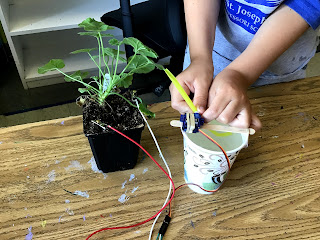SMART Gardening - Moisture Sensing, Automatic Plant Watering, & More w/ the micro:bit
Summer Camp 2020 is here and I have to say that this moment has been on my mind for some time now. Two and a half years ago I was asked the question: "If budget were no issue, what would you like to see happening at your school?" What an incredible question. Looking back, it was the question I needed to hear most. There are so, so many good answers to it but I wouldn't be here now if the idea of STEAM learning hadn't have been what came to mind.
Thousands of hours of exploring, classes, workshops, observing, planning, reading, and dreaming have happened between now and that moment that have led to this becoming a reality, and my goodness what an interesting reality this is. It has been so great to get to laugh and learn with others again.
To kick off the week, we focused on plants. We went outside and in our engineering notebooks we recorded observations, sketched, and wrote down important questions. Our focus was on "What do plants need to strive?", "How do plants meet their needs?", and "How do humans help plants meet their needs?" After some discussion, we talked about technology humans already implement to help plants grow, like irrigation and grow lights. With all of this in mind, we set out to see what we could make that would help our gardens flourish.
Our first step was to make, code, test, and refine a moisture sensor. We created this moisture sensor by utilizing the power of electricity! It turns out that the more moist soil is, the better a conductor of electricity it becomes. By stabbing two nails into the soil of our plant and connecting them to our micro:bit via alligator clips, we were able to create code that had our micro:bits send out a bit of electricity from one nail and measure how much of it got to our second nail.
Next, we constructed our plant watering contraptions. We connected straws to our servo motors and programmed them to tilt the straws back into cups of water and then tilt them forward to dump the water onto our plants. The instructions for this project can be found here! Watch this video to see it in action:
Our last big work was to connect these two pieces of code. We wanted our program to check the moisture level of the soil periodically, determine if the soil was too dry, and if it was we wanted it the automatically water the soil for us. With a bit of coding magic (that you can see for yourself here!) we got this to work. Check out our a clip of what the completed project looks like running on its own:
What an incredible, incredible experience. I can't stress enough how proud I am of the students. They came to camp each day with so much creative energy and positivity. You should have seen some of the stuff they designed during free coding!
I am so excited to get down to business next week with the Raspberry Pi, Python, and Scratch as we learn how to create LED art, selfie-stations, interactive games, wildlife cameras, and much more!


Comments
Post a Comment